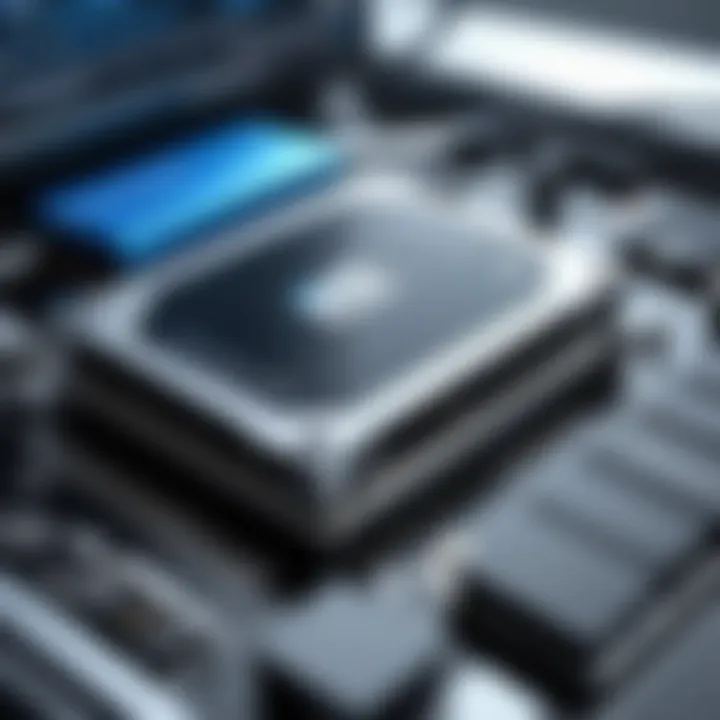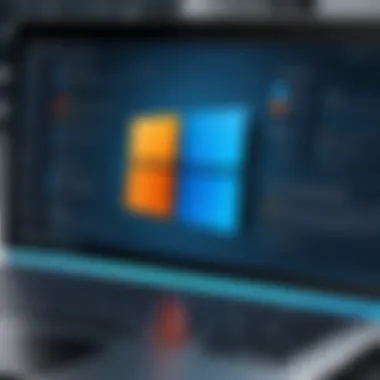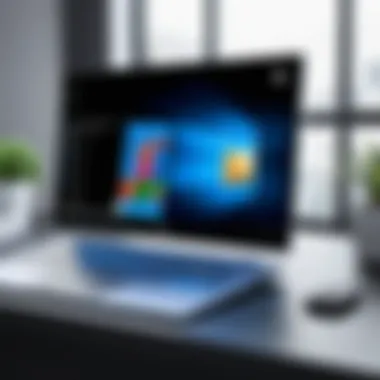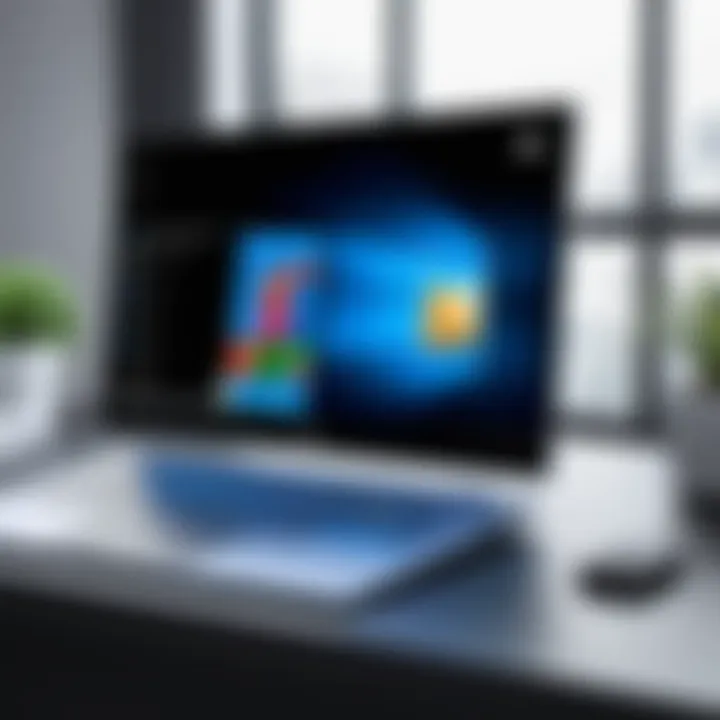Fixing Slow Startup Problems in Windows 10: Expert Tips


Intro
Slow startup times can frustrate users of Windows 10. It impacts workflow and introduces inefficiency from the very moment a user powers on their system. Identifying the reasons for these delays is essential as it lays the groundwork for effective solutions. This article explorens this pressing issue, shedding light on various factors affecting boot times and offering useful tips for improvement.
Understanding the extent to which software, applications, and system settings influence startup speed is crucial for any Windows user. Beyond performance, these delays can range from aggravation to wasted hours. Consequently, this article both highlights pertinent problems and provides actionable strategies to enhance the overall user experience. With the right adjustments, it is possible to restore functionality and improve response times.
In the following sections, we will delve into specific techniques aimed at resolving slow startup issues while empowering readers with comprehensible insights.
Understanding Windows Startup Process
Understanding the startup process of Windows 10 is essential for troubleshooting slow boot times. This specific knowledge allows users to pinpoint where delays may occur and what factors contribute to these inefficiencies. In the grand scheme of optimizing system performance, a clear grasp of startup mechanics can lead to significant improvements in user experience.
Every interaction with a PC begins at startup, making this phase crucial. Whether for personal use or business environments, the efficiency of the system during this initial stage sets the tone for productivity. As slow startups can produce frustration, understanding this process offers both context and actionable insight.
What Happens During Startup
Upon powering on a Windows 10 device, several key actions unfold sequentially. The process begins with the Basic Input/Output System (BIOS) or Unified Extensible Firmware Interface (UEFI). These firmware interfaces initiate a series of tasks that happen behind the scenes and lead towards a functional operating system.
- POST Phase: The Power-On Self Test (POST) checks hardware components to ensure they are functioning correctly.
- Boot Loader: Once POST concludes, control is handed over to the Windows Boot Manager, which is responsible for loading the startup configuration.
- Kernel Loading: Windows kernel loads next, transitioning the system into protected mode, with memory management functionalities in place.
- System Drivers: Essential drivers for the hardware hit the screen; these are loaded to allow proper communication between Windows and components like graphics cards or network devices.
- User Session Handler: This service sets up user environments once drivers are loaded. Here, the user profiles are initiated but not actively displayed until
- Login Interface: Finally, Windows presents the login screen, allowing users to access the desktop.
Any delays or malfunctions at these points can lead to protracted startup times. Recognizing this sequence helps in identifying at what junctures your system may be encountering issues.
Key Components Involved
Awareness of the components involved in the startup process reveals how individually these elements matter. Several core components help craft this sequence:
- BIOS/UEFI: This first layer acts as the foundation for launching Windows.
- Startup Configuration: Often found in the System Configuration menu, these settings govern which files and applications load during startup.
- Boot Managers: These are pivotal in managing which operating system is booted if multiple options exist.
- Kernel and Drivers: As integral mediators, they permit Windows to directly communicate with the hardware and ensure system functionality.
- User Profile Database: Holds settings, preferences, and store specific configurations for personal user environments.
Tip: Familiarizing yourself with these components will not only facilitate diagnostics but empower you to implement solutions effectively. Knowing how these engage during startup assists in addressing slow boot issues more precisely.
By understanding these processes, users can delve into the specifics, pinpoint weaknesses in performance, and tackle slow startup issues head-on. Increased knowledge equips users with the ability to make educational choices on troubleshooting steps moving forward.
Common Causes of Slow Startup
Understanding the common causes of slow startup is essential in addressing the issues many users face with Windows 10. This section provides insights into key elements that contribute to sluggish boot times. Identifying these causes allows users to implement targeted enhancements, ultimately leading to a smoother experience. By honing in on these specifics, readers can make informed decisions on how to optimize their startup processes effectively.
Too Many Startup Programs
One significant factor that can lead to slow startups is the accumulation of too many startup programs. Every time a user logs in, Windows attempts to load these applications, consuming valuable system resources. Programs set to launch at startup may include unnecessary software that users rarely or never use. Eliminating these from the startup list can yield noticeable improvements in boot time, enhancing system performance into the bargain.
To manage these applications, users can access the Task Manager. This interface provides information regarding which apps are utilizing resources during startup. Simply disable unwanted programs and monitor the impact on system responsiveness. Regular inspections will help maintain an optimized environment.
Disk Fragmentation
Disk fragmentation occurs when files are scattered throughout the hard drive rather than maintained in contiguous sections. This scattering can significantly slow down the process of loading files during startup. As Windows attempts to access different fragments of a file, the time it takes to boot increases considerably.
Defragmenting the drive organizes data and enables the operating system to access files more efficientely. Users should use the built-in defragmentation tool in Windows 10 to perform routine maintenance. Running such a tool periodically can contribute to better startup performance and extending the drive’s longevity.
Hardware Limitations
Hardware limitations also play a notable role in slow startup scenarios. Devices with insufficient resources—such as processors that lack speed or limited memory—struggle to cope with multiple tasks, including those required during startup. Older systems or budget configurations may show these limitations more evidently.
When performance is slow, consider evaluating the current hardware setup for cost-effective upgrades. Assessing the speed of your processor and the amount of RAM present can provide clarity on limitations. Upgrades, while they may have upfront costs, can result in substantial long-term gains in functionality.
Outdated Drivers
Lastly, outdated drivers can leave systems vulnerable and impact startup speeds negatively. Drivers ensure that hardware components operate properly and communicate efficiently with the operating system. Manufacturers release updates that can enhance performance and fix bugs which may otherwise hinder operations.
To counter this, regular checks for driver updates should be part of any maintenance routine. Using Device Manager effectively checks for outdated drivers and assists with the update process. Implementing these updates can result not only in faster read and write times during startup but also enhance general system stability
These commonly overlooked factors can profoundly affect Windows 10 startup. By recognizing and addressing them, users can initiate effective changes that lead to notable performance improvements.
Assessing Your Current Startup Configuration
Assessing your current startup configuration is crucial for identifying unnecessary complications that may slow down your Windows 10 system's performance. Having a clear understanding of which applications and processes initiate during boot time allows for targeted improvements. An effective startup configuration management can significantly reduce boot times, optimize resource usage, and ultimately lead to a smoother user experience.
Accessing Task Manager
To start assessing your startup configuration, you will first need access to the Task Manager. This tool provides valuable insights into all programs that run when your system powers on.
You can open the Task Manager with these simple steps:
- Right-click on the Taskbar at the bottom of your screen.
- Select Task Manager from the context menu.
- If the Task Manager opens in a simplified view, click on More details.
The Task Manager will then present you with multiple tabs. Click on the Startup tab. Here, you will find a comprehensive list of applications that are set to launch during boot. The list will also display the Startup impact for each application, allowing you to gauge how much pressure an application has on your startup performance.
Reviewing Startup Impact
Having accessed the Startup tab, your next actions involve carefully reviewing the impact of each startup application registered on your system. The Startup impact column categorizes applications based on their effect on boot times. You will typically see classifications such as Low, Medium, or High.
Factors to consider during your review include:
- Priority of Applications: Determine which programs are essential for immediate startup. Often, applications related to security software, system updates, and crucial drivers should remain enabled.
- Non-essential Software: Identify any unnecessary applications that you rarely use. These programs may create delays that significantly hinder startup performance.
- Trial Applications and Bloatware: Certain pre-installed applications may not serve your actual needs. Review these carefully to decide if they can be disabled or uninstalled altogether.
By doing a thorough review of the startup items based on their impacts, you will be better positioned to create a streamlined startup process that contributes to a faster, more efficient system.
Remember, a well-maintained startup list is necessary for optimal Windows 10 performance.
Assessing your current startup configuration, therefore, should not be viewed as a one-off task but rather a necessary routine to follow as software and user behavior evolve.
Disabling Unnecessary Startup Programs
Disabling unnecessary startup programs can greatly influence the boot time of your Windows 10 system. When too many applications launch at startup, they consume system resources and extend load time. The more applications you have trying to initialize simultaneously, the slower your system can boot. Streamlining this process leads to more efficient startup times, allowing users to jump into their work or leisure activities more efficiently.


Moreover, keeping only essential programs running at startup helps reduce operating system overhead. This practice not only speeds up boot time but also reduces memory usage right from the onset. Ensuring your system handles only necessary applications provides a more pleasant user experience, thus enhancing overall system usability.
Identifying Non-essential Apps
Identifying non-essential applications is a critical step in optimizing startup processes. Start by examining which programs you install frequently. Every software you install may request to launch when Windows starts, but not all of them are necessary. These often include software like cloud services, validation checks, and instant messaging applications.
To identify non-essential apps, follow these steps:
- Use Task Manager: Bring up the Task Manager by pressing . Click on the Startup tab to see a list of applications configured to start when Windows boots.
- Evaluate Startup Impact: Each application shows its startup impact -- either Low, Medium, or High. This rating helps display which apps take more resources to boot.
- Consider Your Usage: Think about whether you regularly use the applications at startup. Commonly unnecessary programs include non-critical software, third-party music playback apps, and certain software with lower usage priority.
Steps to Disable Applications
Disabling applications in Windows 10 is a straightforward process. Here’s how to safely and effectively disable unnecessary startup applications:
- Open Task Manager: Either right-click on the Taskbar and select Task Manager or press .
- Select the Startup Tab: Navigate to the Startup tab where you will find a list of applications that start with Windows.
- Analyze Entries: For each application, right-click on an entry you wish to disable. Ensure its impact score doesn't outweigh its necessity for your daily tasks.
- Disable Non-essential Apps: Click Disable for those applications deemed unnecessary. You can always re-enable them later if you find you need them.
- Exit Task Manager: After making your changes, exit Task Manager. Your next system boot will reflect these updates.
Disabling unnecessary startup programs provides a beneficial timeline, every system literally stands to gain. Should you ever need those applications, they can always be accessed from the programs folder without them burdening the boot procession. This proactive management ensures that your device performs optimally, keeping factored elements within control.
Optimizing Hard Drive Performance
Optimizing Hard Drive Performance plays a crucial role in addressing slow startup issues in Windows 10. A well-maintained hard drive allows the system to read and write data more quickly. Consequently, this can reduce boot times and enhance overall user experience. Over time, hard drives can become cluttered or disorganized, leading to inefficiencies. Thus, regular maintenance becomes necessary to keep your system running smoothly.
Defragmenting Your Drive
Defragmenting your drive can significantly contribute to improved performance. When data is written to the disk, it may not occupy contiguous spaces. This can result in fragmented files, which makes the operating system work harder to access them. The process of defragmentation reorganizes the scattered files into a contiguous block. This not only speeds up access times but also optimizes space usage on the hard drive.
To defragment your drive, do the following:
- Open the Start Menu and type Defragment.
- Select Defragment and Optimize Drives.
- Choose the appropriate drive and click on Optimize.
After processing, the tool will display the necessary information about fragmentation. It is ideal to run defragmentation tool regularly, depending on how frequently files are added or deleted.
Using Storage Sense
Storage Sense is a valuable feature available in Windows 10, designed to help manage disk space more effectively. It automates the process of removing unnecessary files, thus improving hard drive performance. Files like temporary files, and items in the recycle bin can accumulate and occupy vital storage.
By enabling Storage Sense, users can set specific parameters such as:
- Automatically delete temporary files that apps are not using.
- Clean up downloads that have not been opened in a predefined duration.
- Ensure that the recycle bin does not retain files longer than a set period.
To access Storage Sense:
- Go to Settings > System > Storage.
- Toggle the Storage Sense switch to On.
- Configure the desired preferences based on individual needs.
Employing Storage Sense not only celebrates efficiency but also frees up the hard drive for effective performance.
Regular maintenance of the hard drive through these methods is important for optimizing your Windows 10 experience.
Upgrading Hardware for Better Performance
Upgrading hardware can significantly impact the performance of Windows 10 startup. While software optimizations help, certain hardware enhancements will provide the best results. An SSD allows systems to boot faster than traditional hard drives, while increased RAM helps run multiple programs smoothly.
Benefits of Upgrading:
- Faster Boot Times: Swap out newer components that will improve load times.
- Enhanced Multitasking: More RAM lets users work with many applications at once.
- Increased Lifespan: Modern hardware can support newer software updates longer.
This article will focus on two substantial upgrades, installing an SSD and increasing RAM capacity. These changes require investment but typically result in noticeable performance improvement.
Installing an SSD
Solid State Drives (SSDs) have become standard upgrades for modern computers. They use flash memory which allows for much quicker data retrieval compared to traditional Hard Disk Drives (HDDs). As a result, boot-up times and application load times decrease dramatically.
Benefits of SSDs:
- Speed: SSDs provide much lower read and write times.
- Durability: They lack moving parts, lowering the chance of mechanical failure.
- Less Power Consumption: This efficiency can lead to longer battery life on laptops.
Considerations When Choosing an SSD:
- Capacity Needs: Users should evaluate how much data they intend to store.
- Type of SSD: SATA SSDs are cheaper but NVMe SSDs provide much greater speed.
- Budget: Quality SSDs can vary significantly in price based on speed and capacity.
Updating System Drivers
Updating system drivers is a crucial aspect of maintaining optimal performance in Windows 10. These drivers act as intermediaries between the operating system and hardware components, ensuring they communicate effectively and efficiently. Keeping them up to date has several benefits, including improved stability, increased performance, and added features for peripherals.
Outdated drivers can lead to conflicts with the system, resulting in slow startup times and unexpected crashes. Therefore, investing time in regular updates is not only beneficial but necessary for a smoother computing experience.
How to Check for Updates
To begin checking for driver updates, start with the Windows Settings. Follow these steps:
- Open Settings: Press the Windows key and click on the gear icon.
- Navigate to Update & Security: Select ‘Update & Security’ from the menu.
- Click on Windows Update: In the left column, choose . Here, you can check for general updates but also system drivers.
- Check for Updates: Click the button. The system will search for updates that include not just software updates but drivers too.
If Windows finds updates, follow the on-screen prompts to install them. Remember that this method updates drivers that Microsoft supplies. Alternatively, visiting manufacturer websites can provide driver updates specific to your hardware.
Using Device Manager
Device Manager is a powerful tool for managing and updating drivers. It allows for more granular control over the hardware.
To utilize Device Manager:
- Open Device Manager: Right-click on the Start button and select .
- Locate the Device: In the Device Manager window, find the hardware component that you want to update, such as for graphics drivers.
- Right-click and Select Update Driver: Upon finding the hardware, right-click on it and select from the context menu.
- Choose How to Search for Drivers: A prompt will appear giving you two options: Search automatically for updated driver software or Browse my computer for driver software. The first option usually finds the best available driver directly through Windows. The second allows you to locate and install a specific driver you’ve downloaded.
Regular updating of drivers improves system stability and performance significantly.
You can also uninstall a driver here if it causes issues, allowing Windows to reinstall it upon reboot. This process can resolve conflicts due to corrupted drivers.
By systematically addressing driver updates, users can ensure their systems operate optimally, potentially mitigating slow startup occurrences. Staying informed about updates enhances the technical aspect of Windows 10 management.
Managing Background Processes


Managing background processes is crucial in optimizing the performance of your Windows 10 system. These processes consume CPU, memory, and other system resources, which can significantly slow down the startup time. Identifying which applications run in the background and how they impact resource allocation will help in streamlining your startup experience. Smaller load during startup often translates to quicker access to the system and improved responsiveness overall.
Identifying Resource-Heavy Applications
To effectively manage background processes, firstly, you need to identify which applications are using significant resources. This can be done through the Task Manager, a powerful tool built into Windows 10. Launching Task Manager can be accomplished by:
- Right-clicking the Taskbar and selecting , or
- Pressing on your keyboard.
In the Task Manager, navigate to the Processes tab. Here, you can view a detailed list of all running applications and their resource use:
- CPU Percentage: Indicates how much processing power each process is consuming.
- Memory Usage: Shows the amount of RAM being utilized by applications.
- Disk Activity: Illustrates how much disk access a particular process requires.
By evaluating these metrics, you will discern which applications are the most resource-intensive. If a non-essential application is occupying a considerable share of resources, you might consider disabling or uninstalling it to elevate startup speeds.
Ending Processes Safely
Once you have identified the resource-heavy applications, you might need to end certain processes to free up system resources. However, it is critical to do this carefully to avoid affecting system stability. Follow these steps to safely end a process:
- In Task Manager, once again go to the Processes tab.
- Right-click the specific application you want to terminate.
- Select End Task from the dropdown menu.
It is important to exercise caution when ending processes. Ensure that the application is not part of Windows essential functions or a critical system process. Ending an important task may lead to data loss or system instability. If unsure, it is better to research the process before terminating.
Ending non-essential background tasks can provide immediate improvements to startup time and overall system responsiveness.
By actively managing background processes, Windows 10 users can significantly boost boot times and optimize their systems for faster performance. Regular review and assessment of these running applications will ultimately lead to a smoother technology experience.
Disabling Startup Delay Settings
Disabling startup delay settings can play a crucial role in optimizing your Windows 10 boot time. This aspect directly affects how quickly your system becomes operational after you power it on. When the startup delay settings are enabled, Windows may intentionally hold off on loading some elements to allocate resources for other processes. This can result in a slower startup experience, particularly for users relying on rapid access to programs on boot.
Making changes to these settings can enhance overall performance. A shorter startup time means that users spend less time waiting and more time being productive, which is especially important for professionals who value efficiency.
The benefits of effectively managing startup delays include:
- Faster Boot-Up Times: By minimizing delays, you reduce the wait time.
- Improved Performance: Less wait allows for smoother transitions into other applications post-startup.
- Enhanced User Experience: Immediate access to apps contributes to more seamless daily workflow.
Before proceeding, it is important to consider that changing or disabling certain features might impact startup stability. It is wise to weigh the necessity for speed against possible drawbacks like system responsiveness following power-intensive operations.
Understanding Fast Startup
Fast Startup is a feature in Windows 10 designed to reduce startup times by storing some system information in a hibernation file. Essentially, when you shut down your device, the session is saved, allowing for a quicker boot process the next time you power on. This can provide a signifficant advantage in boot speed, but it works best in specific hardware configurations. Recognizing whether this option is suitable for your setup is important before modification.
There are advantages and disadvantages. The positive aspect is quicker access when you start the device; however, some users might experience difficulty making system updates or roadblocks in dual-boot scenarios due to this feature being active. Anyone attempting to gain optimum operation speeds requires attention to when Fast Startup should be enabled or disabled.
How to Disable Fast Startup
Disabling Fast Startup offers a method to regulate boot time manually. To follow through, you may do these steps:
- Open Control Panel by searching for it in the Start menu.
- Navigate to then select .
- Click on from the left panel.
- Click on .
- Look for the Turn on fast startup option and uncheck the box.
- Finally, click on to finalize your adjustments.
By turning off Fast Startup, you enable a more traditional booting sequence. Although it may introduce longer startup times generally, figuring out the effect on your overall system performance warrants evaluation. Before fully committing is encouraged reviewing various boot speed benchmarks related to your hardware.
Using System Maintenance Tools
System maintenance tools play a vital role in keeping Windows 10 operating smoothly. These tools can help identify issues, clean unnecessary files, and ensure your system performs optimally. Using such tools effectively can potentially resolve slow startup issues by eliminating clutter and repairing system components. The integration of these tools in regular maintenance regimens enhances stability and performance, paving the way for an improved user experience.
Running Disk Cleanup
Disk Cleanup is a pragmatic utility built-in Windows that helps users reclaim disk space. It functions by removing temporary files and system files that accumulate over time and may slow down your device. Users can easily access Disk Cleanup by searching for it in the Start menu. Once opened, it surveys the system and presents an array of file categories that can be deleted, such as:
- Temporary internet files
- Recycle Bin contents
- System error memory dump files
- Other temporary files.
By selecting the categories you want to delete, you efficiently remove unused resources that can cause lags during startup. This simple task can free up considerable space, enhancing accessibility for other files essential for startup.
It is advisable to run Disk Cleanup regularly to maintain overall system health. The reduction in unwanted files promotes a faster response time and a more agile user interface.
Executing System File Checker
System File Checker, commonly referred to as SFC, is a built-in Windows tool designed to scan for and restore corrupted system files. Occasionally, issues during startup can stem from these compromised files, affecting your system’s integrity. To execute SFC, follow these steps:
- Open Command Prompt as an administrator.
- Type and press Enter.
- Wait for the scan to complete, it may take some time.
The tool will automatically detect and repair any corrupted files it finds along the way. This process not only addresses immediate concerns but also ensures your system maintains stability during operations.
SFC is a fundamental component in troubleshooting performance issues. It’s one of the accessible resources for resolving errors, making it a keystone in system maintenance. Consistent execution of SFC can lead to a significantly more reliable startup experience, providing a positive and streamlined interaction with Windows 10.
Adjusting Power Settings
Adjusting power settings plays a critical role in optimizing Windows 10 startup. Often overlooked, power settings can have a direct impact on how quickly a system boots and performs. When a computer is set to maximize performance, it uses more power, which can slow booting processes. Conversely, a power-saving mode may extend startup times as the system conserves energy instead of prioritizing performance.
Selecting the right power plan can make significant difference. The right balance between performance and energy efficiency allows for better resource allocation at startup. Advanced power settings also provide users more control over how power is utilized by various components. This is essential especially for laptops, where battery longevity is a key concern.
Optimizing power settings is essential for improving startup performance in Windows 10. Adjusting these setting can lead to both speed enhancements and better overall system responsiveness.
Selecting the Right Power Plan
Choosing the appropriate power plan is fundamental. Windows 10 offers several power plans, such as Balanced, Power Saver, and High Performance. Each has its distinct characteristics.
- Balanced: This plan automatically adjusts the system to use power efficiently while meeting performance needs. This might be the best for general use, combining both performance and energy-saving benefits.
- Power Saver: This mode is great for laptops wishing to extend battery life. However, it can come at the expense of reduced performance, especially during startup.
- High Performance: This setting maximizes performance by allowing the CPU to run without restrictions. While it can decrease startup time, it leads to higher power consumption.
Utilizing the High Performance plan may be particularly useful when booting up your device. It utilizes more resources to ensure quicker access to system functions, though this should typically be done while a device is plugged into a power source.
Modifying Advanced Power Settings


Once you select the preferred power plan, fine-tuning advanced power settings can provide further benefits. This can include setting timers that can affect energy usage during startup. From the power and sleep settings menu, you can access the advanced settings.
Adjustments could include:
- Hibernate Settings: Ensure that hibernation is optimized. Excessive use of hibernation can slow down future startups as it reconfigures everything from that saved state.
- Sleep Settings: Configure the sleep timers for when your computer is unused. If a machine goes to sleep too quickly, resuming operations may take extra grants more time in future use.
- PCI Express Settings: This includes options for Link State Power Management. Different configurations here can significantly under or overutilize resources during the startup, impacting overall response time.
Proper adjustments in this area can yield a noticeable effect on boot performance. By understanding power settings well and making informed configurations, users enhance their Windows experience considerably.
Reinstalling Windows as a Last Resort
Sometimes, users face significant slow startup issues that seem insurmountable. When all other methods have failed, reinstalling Windows becomes a practical solution. This option is necessary when your system is sluggish despite trying numerous tweaks and enhancements.
Reinstalling Windows can resolve a range of problems. It can remove old files that clutter your system and can also fix file corruption issues. A fresh installation ensures the OS functions optimally.
Before taking this step, however, it's important to consider various factors—including possible loss of installed applications and user files.
When to Consider Reinstallation
Reinstallation of Windows may be warranted in various scenarios. If a system suffers from persistent slow boot times, unexplained crashes, or severe performance glitches, a fresh start redresses the balance. It is ideal if your machine is inflicted with malware that isn’t easily removed. A maximum benefit is seen when performance becomes substantially unresponsive or operations run at a crawl.
Further, if your Windows version fails to install critical updates successfully or laughs at other fixes to improve speed, reinstallation is worth contemplating. Inconsistent bug performance across different applications may also indicate a kernel or system file pathology needing reset.
Backup Important Data
Before diving into Windows reinstallation, be cautious. Always create backups for important files and documents.
The process to backup is often straightforward and should be treated as paramount:
- Cloud Storage: Services like Google Drive and OneDrive keep your files available online, minimizing data loss risks.
- External Hard Drive: Transfer vital files using an external hard drive to guard against all mishaps.
- Use Backup Software: Softwares such as EaseUS Todo Backup can help automate backups efficiently.
Ensure all critical documents, photos, and settings are secured. Assess the current state of drives within
Regular Maintenance for Optimal Performance
Regular maintenance is fundamental to ensuring your Windows 10 system runs efficiently. As devices age and undergo various updates, they may accumulate redundant files and unused programs. This can contribute to prolonged startup times and overall sluggishness. By establishing a routine of regular maintenance, users can prevent clutter from sapping valuable system resources.
Key aspects of regular maintenance include routine updates and file cleanups. These not only help keep the system efficient but also safeguard against potential vulnerabilities that outdated software may introduce. Consequently, users who embrace a proactive approach often find their systems running more smoothly.
Establishing Update Routines
Establishing consistent update routines ensures your software remains optimized and secure. Regular updates, both for Windows itself and installed applications, close security gaps, improve functionality, and can even tweak performance settings.
Benefits of Regular Updates:
- Improved Security: Updates often include security enhancements to defend against malware and other threats.
- Bug Fixes: Many updates address performance issues from previous versions, providing tangible benefits.
- Feature Enhancements: Updates sometimes bring new features that may improve usability or system speed.
To set a routine for updates in Windows 10, follow these steps:
- Open Settings from the Start menu.
- Navigate to Update & Security.
- Under the Windows Update section, adjust settings to check for updates regularly.
This routine ensures that your machine is equipped with the latest enhancements, reducing potential slowdowns.
Scheduling Regular Cleanups
Cleanups are equally critical as part of maintenance. Scheduling regular cleanups helps users manage disk space and remove unnecessary files.
What to Include in Cleanups:
- Temporary Files: Regularly clear these files created by the system and applications that take up space.
- Browser Cache: Overloaded caches can slow down web browsing and intake unnecessary system resources.
- Recycle Bin: Periodically emptying the Recycle Bin maximizes storage by permanently removing deleted files.
To effectively perform these cleanups, you can utilize the built-in Disk Cleanup tool or advanced options like CCleaner. Running this cleanup once a month can improve startup speed significantly by ensuring only the essential components are retained.
Regular cleaning of unnecessary files is crucial for optimal system performance. Even small changes contribute to better overall operation.
Engaging in regular maintenance doesn't require vast technical knowledge. With simple routines, users can enhance their experience significantly. Keeping the system healthy contributes to a seamless and productive interaction with technology.
User Experience Considerations
User experience is an essential factor when dealing with slow startup issues in Windows 10. A smooth and efficient system directly affects productivity and user satisfaction. If users struggle with lengthy boot times, it leads not only to frustration but also to a perception that the system is underperforming.
Understanding User Impact
The user impact of slow startup times can be classified into several dimensions. Firstly, there’s the immediate productivity loss. When a user turns on their computer, they expect it to be ready for use almost instantly. Delay can disrupt workflows and divert focus from important tasks.
Secondly, users may feel anxious or impatient waiting for their machines to respond. In a professional setting, this can negatively affect time management and resource allocation. It impacts how efficiently tasks can be achieved, which is particularly significant in fast-paced environments.
Moreover, the frustration stemming from consistently slow startups may lead some users to settle for alternatives, thus potentially switching from established systems they are used to. This reflects the importance of maintaining optimal performance in retaining their user base. Less efficient systems can also mean a greater burden on employees, affecting their morale and productivity.
In essence, recognizing the good user experience involves understanding these impacts deeply, thereby allowing for a more targeted approach towards startup improvements.
Gathering Feedback for Improvement
Once the initial understanding of user impact is in place, the next logical step is to gather feedback on their experiences. This feedback can act as a vital resource for continuous improvements. Here are some specific methods to consider:
- User Surveys: Short questionnaires can solicit invaluable insights into startup experiences like frustration levels and suggested modifications.
- Observational Analysis: Conducting sessions where user interactions with the startup process are observed can yield firsthand data about bottlenecks.
- Online Forums: Websites like Reddit or tech forums can provide a platform for sharing experiences, highlighting common problems, and validating existing solutions.
Through these channels, organizations or users can systematically identify specific challenges faced during startup and develop strategies to prioritize improvements. Iteratively refining based on user input will lead to a gradual and sustained enhancement of the operating environment, further solidifying a positive feedback loop.
Culmination
In addressing slow startup issues in Windows 10, it is essential to remember that numerous factors can impact system boot times. This final section summarizes the critical elements covered in the article, offering both a reminder and a guide of actions that can be taken for improvement.
Recap of Essential Steps
When seeking to enhance startup performance, consider the following key steps:
- Assess Current Configuration: Analyze your startup setup to identify resource-heavy applications that slow performance. Task Manager is instrumental in this regard.
- Disable Unnecessary Programs: Through Task Manager, non-essential applications can be easily disabled, reducing load.
- Optimize Hard Drive Performance: Regular defragmentation, along with the use of Storage Sense, aids in enhancing disk access speeds.
- Upgrade Hardware: If possible, installing an SSD and increasing RAM are significant upgrades that lead to noticeable improvements.
- Keep Drivers Updated: Regular checks in Device Manager for driver updates ensure optimal hardware communication with software.
- Manage Background Processes: Identifying and ending unnecessary tasks can free up vital system resources during startup.
- Adjust Power Settings: Selecting an appropriate power plan and refining advanced settings can lead to improvements in performance.
- Implement Regular Maintenance: Establishing a routine for running Disk Cleanup and executing the System File Checker keeps your system in good shape.
Incorporating these steps may help to mitigate slow startup issues effectively. Employ the appropriate strategies based on your needs and monitor changes to system performance following each adjustment. This tailored approach provides a solid foundation for enhancing your Windows 10 experience.
Remember, consistent attention and routine maintenance are pivotal for long-term optimization.



